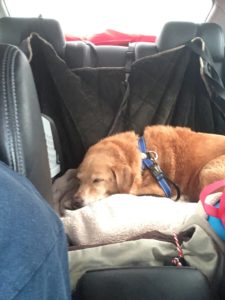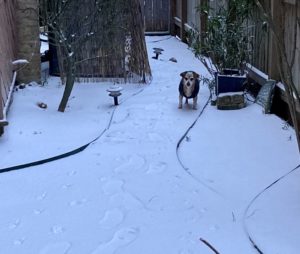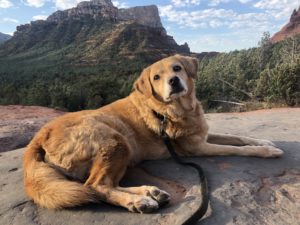Michael Baugh CDBC CPDT-KSA
Behavioral flexibility is our dog’s ability to make adaptive changes in behavior when the environment changes. Adaptive is the key word here. Any dog can (and many do) act impulsively when things around them change. Think: barking, lunging, or even biting. The behaviorally flexible dog isn’t as emotionally charged. His behavior is more intentional. The response to environmental change, though still challenging, is hinged on calmer more deliberate behavior choices. Think: go with the flow.

Many folks assume some dogs are just calmer than others. But, the truth is we can teach behavioral flexibility. We have to be thoughtful about it, yes. Is it difficult? No.
Teach your dog that his choices matter. It is up to us to provide our dogs with meaningful feedback when they make behavior decisions. There are no good or bad behaviors. That may be startling to read, I know. Think of it this way instead. Is my dog choosing an action that will be useful in his life with me or not? Is it a behavior I want to see more of or less of? If it’s useful and we want to see our dog do it more (maybe we even want it to become a habit), then we provide meaningful positive reinforcement for that behavior. Food is always a strong choice.
This is on us. We need to be feedback machines. We are warm and loving, certainly. And, we are providers of constant and reliable information for our dogs. Good, here’s a piece of cheese. Yes, let’s play. More of that, here’s your chew toy. Perfect, let’s go on a walk. Well done, have this bit of chicken. Fantastic, have another. Our dogs will learn quickly that interaction with us (or humans in general) is meaningful and that their behavior choices matter. It’s a conversation across species rooted in trust.

Allow your dog to say no. This is heresy to old school dog trainers, but it’s essential to us now. Forcing or coercing a dog into a behavior choice is really no choice at all. Worse still, punishment stiffens flexibility and kills trust. It leads to escape and avoidance which are very limiting choices. Dogs who are allowed to say no are, in fact, still learning that their choices have meaning. In most cases (dare I say all cases), the “no” is really just a pause. Our dog is trying to figure out what we are teaching him. He’s looking for the “yes.” It’s an opportunity for us to make the lesson a bit clearer, to make it a bit easier for our dog to take the next step, to keep the conversation going.

Teach your dog he is safe. Giving your dog agency in his world – allowing him to make adaptive choices and allowing him to pause and consider those choices – leads back to this one fundamental lesson. He is safe. Working cooperatively with you is safe. Humans are safe. Taking on a new task, whatever it may be, is safe. Novel experiences – safe. New settings – safe. At the core of all of this is a sense of ease and security because we’ve encouraged our dog’s thinking – his choices – and we’ve supported him along the way with positive reinforcement feedback.
Behavioral flexibility is what allows our dogs to take on novel experiences bravely, try things they’ve never tried before, conquer new challenges. Our dogs don’t just learn to do things. They learn how to learn, how to temper and alter their behavior as the environment changes. At age 11 my dog, Stella, learned to climb steps into our bed – and then to climb red rocks high above Sedona. Stewie learned to pee outside at age 2 when we found him, and then how to pee on cue in a hurricane at age 10. When we broke down on the highway they both learned how to ride in a cramped tow truck, because we do new things all the time. They meet dogs sometimes and ignore them other times. Horses and chickens were a curiosity at first, but Stella and Stewie have learned to just take in novel experiences without a fuss. They visit hotels and relatives’ homes – and sleep on beds and dog beds and tile floors and on mats. It’s not always easy, but we take our time when they need an extra few moments to let things soak in.
Life isn’t always chaotic, but it is always changing. Behavioral flexibility, prepares our dogs (and us) when chaos hits – when a flood means leaving home in a boat (or in a helicopter), when humans have to leave or are gone longer than expected, when the ice comes and the house gets dark and cold, when we move to a new home or city or country, when a loved one dies. The more we and our dogs can learn to lean into change, to change with our environment, embrace adaptive behavior over impulsive or reactive behavior – the better off we will be. Teaching our dogs behavioral flexibility is a gift to them and ourselves.
In puppyhood we call this process socialization. There’s a myth that puppy socialization is just letting our puppies play and run amok with each other. But, that’s not it at all. Socialization is about partnering with our dog to take on the world together, to learn new things, to discover new boundaries and take them on (or not), to find safety with each other and in each other every step of the way. It’s a lifelong process. I’d go so far as to say it is what life with our dogs is all about.
So, if we didn’t have our dog as a puppy then when should we start? Now. Right now. Begin with the dog in front of you in the moment at hand. Start easy. Take it easy. Build from where you are together. Challenge yourself to be behaviorally flexible as you guide your dog to behavior flexibly. Notice the conversations you are having with him. Let your actions be a response to his and his to yours. Now you’re talkin’. Worry less about whether or not you can trust your dog. Offer the assurance that he, in fact, can trust you – today and from now on.
Above: Stella and Stewie showing off their behavioral flexibility going outside to potty during Hurricane Harvey.
Michael Baugh CDBC CPDT-KSA is a dog trainer in Houston, TX. He specializes in helping families with dogs with fearful and aggressive behavior.
